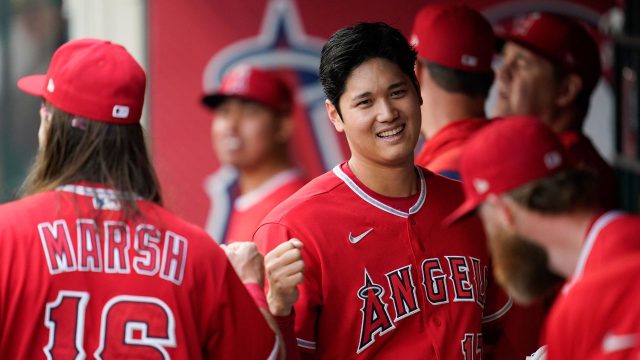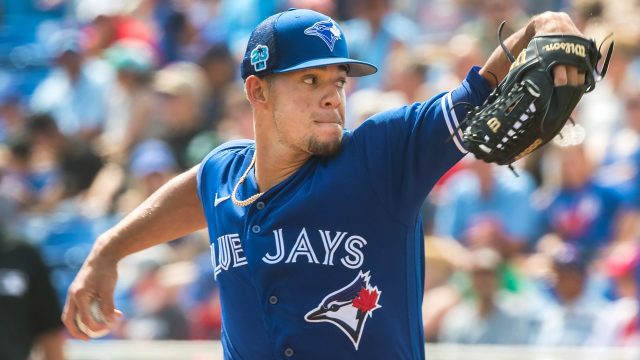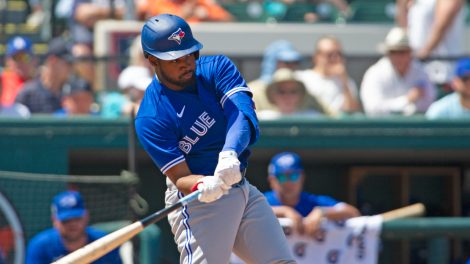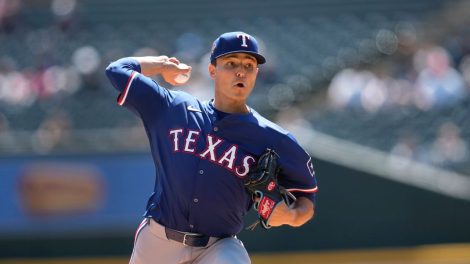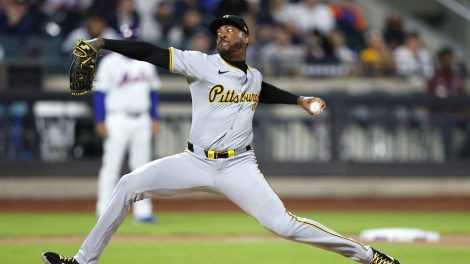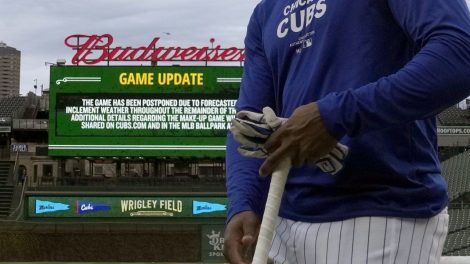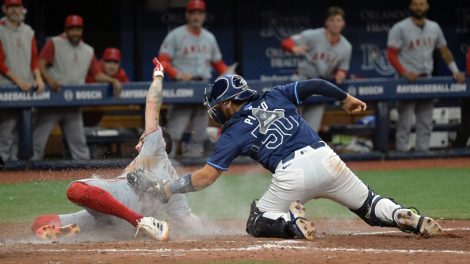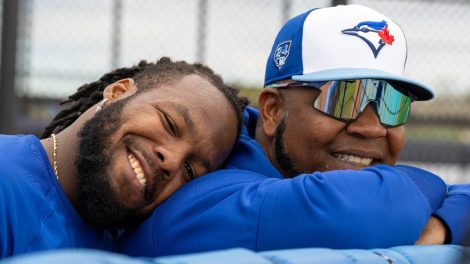ST. LOUIS – There is a maturity in Alek Manoah’s outlook that belies his age, the wisdom of an old soul tethering the fervour of youth to the realities of where he came from and who he is, the privilege of his ample physical gifts never blinding him to what really matters.
That’s why, on the eve of his first opening day start for the Toronto Blue Jays, the 25-year-old right-hander sat in the visitors’ dugout at Busch Stadium pondering his rapid rise from 2019 draft pick to the 2022 Cy Young Award finalist, and said, “everything’s surreal. Everything.”
“Life has taught me a lot,” he added later. “I’m super grateful for everything that I’ve endured in life and some of the adversities that I’ve had to go through and everything that baseball has taught me. It’s allowed me to be better in life. And life has taught me to be better at baseball. I try to look at the bigger picture and understand it’s bigger than just wins and losses. Some of those relationships, family members and how you treat people, things like that, mean a lot more. When you focus on those things, the other stuff kind of just falls into place.”
In so many ways, Manoah is reflective of where the Blue Jays are at the dawn of the 2023 season. Accomplished beyond their years. Oozing talent and ambition. Seeking to grow beyond past adversities. Determined to lock in on the right things, creating a greater whole.
Much as the big man notes “a lot has happened so fast,” for him on a personal level, the same applies collectively to the Blue Jays. They lost 95 games in 2019, the year he was drafted. They won 32 times and made the expanded playoffs during the pandemic season of 2020. A year later, during the three-home-city odyssey of 2021, they fell one agonizing game short of the playoffs on the last day of the season. Last year, they experienced actual tragedy when first base coach Mark Budzinski lost his daughter Julia in a boating accident and then endured baseball heartbreak during the Game 2 collapse against the Seattle Mariners in the wild-card round.
The best appears to be ahead for both Manoah and the club, too. But the different pieces on a team don’t always move at the same pace. Pivotal players have already come and gone, Marcus Semien and Robbie Ray two winters ago, Teoscar Hernandez, Lourdes Gurriel Jr. and Ross Stripling this past off-season and more change looms. Matt Chapman, Hyun Jin Ryu, Kevin Kiermaier, Brandon Belt and, potentially, Whit Merrifield are eligible for free agency this fall. Danny Jansen and Yusei Kikuchi are up after 2024. Vladimir Guerrero Jr., Bo Bichette, Jordan Romano and Chris Bassitt are a potentially direction-altering cohort after 2025.
Windows of opportunity can be fleeting in that way. There’s time, there’s time, there’s time and then very suddenly there isn’t. Recognizing this, the Blue Jays are pushing far more aggressively this season than ever before. Their opening day payroll for luxury tax purposes is projected at roughly of $250.5 million, per FanGraphs’ RosterResource tracker, well past the first Competitive Balance Tax threshold of $233 million and creeping toward the second at $253 million. That means the Blue Jays will face a surcharge of 20 per cent for every dollar spent over and above the first line, and 32 per cent for anything above the second. Those are the rates for a first-time payor like the Blue Jays, with the surcharges escalating each year a team is beyond the CBT thresholds. If they stay there next season, they’ll pay 30 per cent on anything over $237 million and 42 per cent on anything above $257 million. They’re really playing for keeps now.
The flip side is that there’s an expected return on investment for spending at those levels and there’s a through line from last year’s trade deadline to now that’s worth noting.
Beginning with the acquisitions of Merrifield, Anthony Bass, Zach Pop and Mitch White last summer, the Blue Jays have deliberately concentrated more of their organizational capital in the 26-man roster. Their farm system, only two years ago a consensus top five in third-party talent rankings, is now in the lower half of the majors after trading away Gabriel Moreno, along with Gurriel, for Daulton Varsho, even with the addition of prospect Adam Macko, who came back with Erik Swanson for Hernandez.
All those moves have been transformative in multiple ways at the big-league level. Varsho, in the first of his four years of contractual control, gives the Blue Jays both a long-term option for centre field, something they don’t have in the system, and an immediate defensive upgrade with power from the left side of the plate. Swanson, along with Bass and Pop, deepen what had been a thin bullpen group and buy time for one of a host of power arms in the minors, Nate Pearson front and centre, to emerge as consistent contributors. Merrifield, with his elite speed, high-contact at-bats and positional versatility gives manager John Schneider options to attack in various ways. The free-agent additions of centre-fielder Kiermaier, DH Brandon Belt and veteran starter Bassitt provided doses of on-field impact and off-field presence and professionalism.
Dovetailing with those changes is the focus on attention to detail and play on the margins that Schneider, along with his coaching staff, has emphasized since he replaced the fired Charlie Montoyo last July. His consistency, presence and communication have set not just an expectation but also provided a why behind every drill the Blue Jays do and the moves they make.
Perhaps the best example of that was the work put in to acclimate players to baseball’s new rules and the experimentation with ways to most effectively use them during the consequence-free days of spring training. Between chaotic drills and boundary-pushing attempts in exhibition games, they seem to have found a comfort level with the changes.
“We’re good enough to where we don’t have to try to trick anyone. If there are situations that we can take advantage of because of the clock, we will,” said Schneider. “My biggest hope is that all of our guys are comfortable within the parameters of the rules. It’s not being rushed in the box. It’s not being rushed to get the next pitch off. It’s making sure you throw the ball around quickly enough after a strikeout so the next pitch to the hitter isn’t rushed. Things like that. They’re ready for it. There have been a million different things that have come up that we’ve addressed throughout camp. We’re kind of tweaking things here and there, trying to come up with new ways to do it. We’re not going to try to reinvent the wheel. I’ve told the guys, try not to think about it. If anyone needs to get thrown out, it’s going to be me, not you. I don’t think it should be much of an issue.”
Given the talent, the moves and the investment, there are rightfully high expectations of the Blue Jays, and, obviously, risks, too. Front and centre are whether Jose Berrios and Yusei Kikuchi can perform more effectively than they did a year ago, particularly essential given how the Blue Jays are relatively thin behind them, with White slated to open the season on the injured list, Zach Thompson the No. 1 depth option ahead of a group including veterans Drew Hutchison and Casey Lawrence plus farmhands like Bowden Francis and Thomas Hatch.
Electric lefty Ricky Tiedemann could force his way into a breakthrough but the Blue Jays will be extra cautious with the 20-year-old, who’ll open at double-A, likely limited to shorter outings for the first half of the season to keep him available for the back half of the year. Also at New Hampshire will be Sem Robberse and Jimmy Robbins, two other pitchers who are being groomed in the traditional starter mould. At triple-A, power arms like Yosver Zulueta and Hayden Juenger will do some starting but may very well end up in varied-usage roles.
Along with hard-hitting infield prospects Addison Barger and Orelvis Martinez, that group of players makes up the bulk of the Blue Jays’ near-term future capital. There is talent lower down the system but the further a player is from the majors, the more volatility in possible outcomes. For that reason, the next wave of players to help turn over the big-league roster and maintain the current competitive window is unclear, underlining the urgency of leveraging the big-league roster now.
The next wave is, of course, tomorrow’s problem, one very much second in priority to the collective push on a present that arrived fast, maybe faster than expected, and can slip away just as quickly. In Manoah on the opening day mound, they have not only the embodiment of the former, but also a representative of what is needed to ensure they avoid the latter, too.



